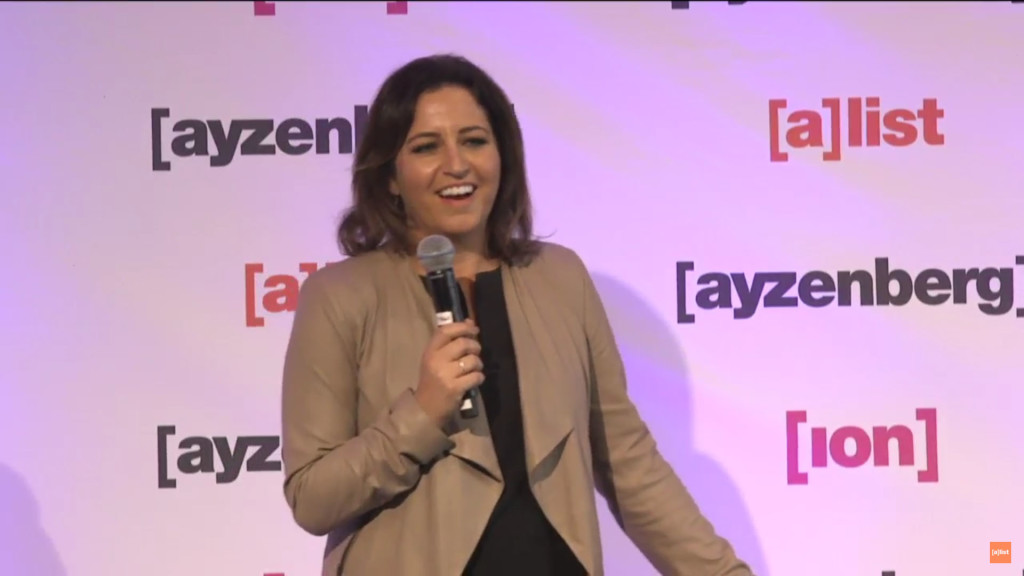The 12th edition of the [a]list summit is underway today from Seattle, where marketing experts come together to exemplify what it means to be Frontline. Keynote speakers included Ruth Yomtoubian, director at AT&T Foundry, which creates, implements and commercializes innovative projects for AT&T. Its network of innovation centers explore new technologies that help serve startups, developers and partners like Cisco, Ericsson and Intel.
Yomtoubian’s keynote explained AT&T’s approach to innovating an experiential and Frontline brand using the Foundry model. She recounted her history in bridging the gap between startup and corporate culture, starting with her time living in New Orleans after Hurricane Katrina, where conditions forced business owners to become entrepreneurs as they rebuilt the city. Then she spoke about her first year at AT&T, where she managed a team of technicians in Oakland and Berkley, sometimes literally driving an F-150 around and learning to understand the dashboards and operational mindset.
She also states of AT&T has a 100-year legacy of transformation, but can sometimes fall into a trap of being unable to take risks, which is why the Foundry was formed. You have to “disrupt from the inside out,” and have the room to bring in new ideas and absorb them.
Innovation is continuously changing and covers a huge multitude of topics according to the times. Plus, there’s a lot of “faux innovation,” where something is just called innovative without looking any deeper into it. So, in order to handle the “innovation overload,” brands have to find ways to cut through the noise.
To this end, Yomtoubian offers nine brand indicators that the Foundry uses:
- Open and flexible space: A team’s mindset is completely changed when everyone isn’t in cubicles and walled off. There’s a better exchange of ideas.
- People: In a process referred to as Engineering Serendipity, you need the right people in an innovation center, because they represent your brand. They need to be collaborative and open, and most importantly, they need to be able to handle ambiguity. Prospective team members are asked how have they been able to create value in an environment of ambiguity in interviews. They have to be willing to try new things.
- Culture: A team’s culture has to be collaborative and experimental. We have to, as a culture support each other, in talking to startups and developing new technology. Partnerships are in the DNA of the Foundry.
- Outreach and inreach strategy: The team must connect with stakeholders with an informed point of view. Startups may come knocking on our door, and the brand should be aware of the technology that’s available, or already in the works. Sometimes, companies just some perspective on what’s innovative. The Foundry has interacted with over 1,500 start-ups, VCs, developers and thought leaders to forge new partnerships. It has also spoken to Government representatives about the meaning of innovation and how they can support it. The goal is to create an entire digital experience, but people won’t know that if they’re not openly communicating it.
- Approach to work: Yomtoubian discusses a “bias towards action.” For example, the Foundry was approached with an acoustic recognition technology that could potentially help with public safety. Instead of creating a budget and plan, the team decided to experiment with the technology first, then come up with applications. Long development cycle has a low tolerance for risk, so projects at the Foundry are generally comprised of 90-day sprints. Teams offer a one or two-page inception document and get to work on a proof of concept instead of doing long-term projects.
- Projects as catalyst: Companies must ensure work can be absorbed back into the business. The On Ramp connected car platform explored what experiences consumers wanted from a connected car. They discovered new ways consumers wanted to use the connected car, then created a platform and APIs to support them. A similar approach was used for Cascade, messaging service that unified different phone numbers into one. It became a catalyst for other projects involving identities.
- Engaging with startups: In order to bridge the gap between startups and corporate culture, the Foundry must act in the role of both translator and guide. They help coach startups on how to talk to AT&T executives, so that they don’t spend too much time talking about the wrong topic. At the same time, it helps startups understand how different organizations can help them.
- Provide a platform: AT&T is showcased as a thought leader in the broader tech industry through an online video series called Futurecast. These are curated, intimate discussions with thought leaders designed to vet, debate and ultimately spark ideas that will help determine the course of technology. As a result, startups benefit in the “reflected glory” of the AT&T brand, where it becomes a platform for them to share their technologies and thoughts. These speakers end up becoming “brand ambassadors,” because they have their own following that they bring, which helps elevate AT&T’s brand as a future-thinking and innovative.
- Partnerships: The Foundry seeks to find “alignment at the cusp of startups and corporate.” They do so by sponsoring discussions, like with the Futurecast platform, to find brand alignment. A prime example of this is with the exploration of drone technology, which is expressed through partnerships with companies like RocketSpace. RocketSpace helped create a futurist report to showcase AT&T’s point of view around drone technology.

